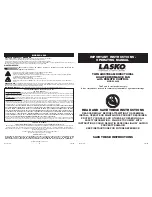
7
IT
IT
GB
GB
3. BILANCIAMENTO E REGOLAZIONE DELL’IMPIANTO
3. BALANCING AND SETTING THE SYSTEM
3.1 Esempio di dimensionamento
3.1.1 Regolazione a punto fisso
Dati di progetto:
P
= potenza da fornire all’impianto a pavimento = 6000W
Tip
= temperatura di mandata impianto a pavimento = 40°C
Tc
= temperatura acqua proveniente da caldaia = 70°C
Δ
Tip
= salto termico di progetto impianto a pavimento = 5°C
Tr
= temperatura di ritorno impianto a pavimento = Tip –
Δ
Tip = 40 – 5
= 35°C
Qip
= portata impianto a pavimento = (P[W] x 0,86) / (
Δ
Tip) = (6000 x
0,86) / 5 = 1032 l/h
Δ
P valv
= perdita di carico valvola di regolazione
Dal diagramma sottostante alla portata di 1032 l/h corrispondono
6 curve diverse corrispondenti alle diverse regolazioni del by-pass
(rif.
fig. A): minore è l’apertura del by-pass minori sono i tempi di
reazione della valvola miscelatrice alle variazioni di temperatura e più
rapidamente viene raggiunta la temperatura di mandata richiesta, al
contrario l’apertura del by-pass riduce le perdite aumentando la portata
all’impianto e riducendo, al contempo, i pendolamenti della temperatura
di mandata dovuti all’apertura-chiusura delle varie zone in cui è suddiviso
l’impianto di riscaldamento.
Diagramma Circolatore Yonos Para
Yonos Para Circulator Diagram
3.1 Dimensional example
3.1.1 Thermostatic regulation
Project data:
P
= capacity to provide to the floor-mounted system = 6000W
Tip
= delivery temperature of the floor system = 40°C
Tc
= temperature of the water coming from the boiler = 70°C
Δ
Tip
= project temperature drop of the floor-mounted system = 5°C
Tr
= floor-mounted system return temperature = Tip –
Δ
Tip =
40 – 5 = 35°C
Qip
= floor-mounted system flow-rate = (P[W] x 0,86) / (
Δ
Tip) =
(6000 x 0,86) / 5 = 1032 l/h
Δ
P valv
= control valve pressure drop
From the diagram underneath the 1032 l/h flow rate, there are 6 different
curves that correspond to the various bypass adjustments (ref.
fig. A):
the less the bypass opens, the shorter the response time of the mixing
valve to the temperature variations and the requested delivery tempera-
ture is reached in a shorter amount of time. Conversely, the opening of
the bypass reduces the drops by increasing the system’s flow-rate and
simultaneously reducing the flow temperature oscillations due to the
opening-closure of the various areas the heating system is divided into.
Perdite carico gruppo miscelazione
Mixing unit pressure drops
100
1000
10
0
0
0
0
1
0
0
0
1
0
0
1
0 Kv=3
1 Kv=3,4
2 Kv=3,8
3 Kv=4,2
4 Kv=4,5
4 Kv=4,5
5 Kv=4,8
0
Δ
p [mbar]
Q [l/h]
Δ
p-c
max.
Δ
p Costante
1
2
3
4
5
6
0,5
1,0
1,5
2,0
2,5
0
3,0
Q [m
3
/h]
H [m]








































